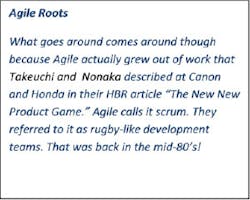With software becoming an increasingly important part of product development, Agile software development methods are becoming better known. Let's take a look at Agile and how some of its key elements can help you uncover hidden new product innovation capacity. For a more comprehensive overview you might want to have a look at the Agile Manifesto.
The idea is to start with a minimum viable product that you can quickly get into the market while continuing to learn what customers need and will pay for in future revisions. In this way, changes in the middle of a project are welcomed.
It's a very straightforward approach if you are launching a software-based product. A little harder if you are developing the next variant of the 787 airliner or the next generation of riding lawnmower where changes can mean significant delays. While requirements should always be challenged (Is that feature really necessary? And what about that one…), many physical products just can’t be marketed until they are fully functional with a pretty rich set of features.
But it’s really important to realize that planning-based project management processes, like critical chain project management, are not inherently waterfall in nature. They just appear that way because that is so often how executives structure stage & gate processes without thinking about the effect on flow and speed.
So let’s look at an example of a how a typical project phase can be made less waterfall and more Agile. In the case of a paint adhesive or development process, the formulation group often works up a number of samples and then passes them all over at the same time to the applications testing group for evaluation. If formulation and testing each take 1 day,
So think about what you can do to make your new product workflow and project plans less waterfall and more agile. It’s a great way to uncover additional capacity by getting projects done sooner.
Looking to uncover hidden capacity and make your new product development more Agile? Mike Dalton's Guided Innovation Group has helped companies improve on-time performance and double throughput and speed without added resources. Download their Agile vs. Critical Chain Diagnostic to help you see which fits your situation best.







